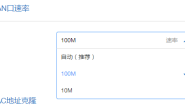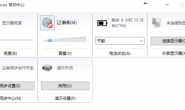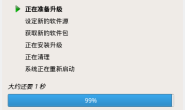对于硬盘的坏道的确没有什么好的办法,ata协议中的smart命令本意上是好的,但是很多的硬盘厂商并没有很好的实现smart的功能;硬盘的相关错误信息会存在相应的扇区里,但是这些扇区相当于一个环形的缓冲区,所以记录的错误信息有限,如果需要完整的硬盘坏道信息,smart就无能为力了。通过完整的读一遍硬盘可以找出坏道的完整信息,但是读牵涉到了DMA的数据传输过程所以效率较低;ata的协议里READ VERIFY (EXT)命令大大提高效率,该命令是NO DATA类型的;以下是具体的代码:
#include <stdio.h>
#include <string.h>
#include <unistd.h>
#include <stdlib.h>
#include <linux/hdreg.h>
#include <linux/types.h>
#include <sys/stat.h>
#include <scsi/sg.h>
#include <scsi/scsi.h>
#include <sys/ioctl.h>
#include <linux/fs.h>
#include <fcntl.h>
#include <errno.h>
#include <sys/time.h>
#define ATA_DRQ (1 << 3) /* data request i/o */
#define ATA_ERR (1 << 0) /* have an error */
#define DRIVER_SENSE 0x08
#define CONDITION_GOOD 0x02
#define ATA_PASS_THRU_12 12
#define ATA_12 0xa1
#define ATA_PASS_THRU_16 16
#define ATA_16 0x85
#define CMD_NO_DATA (3 << 1)
#define FOR_SENSE_DATA 0x20
#define CMD_VERIFY_EXT 0x42
#define CMD_VERIFT 0x40
#define u64 unsigned long long
#define u32 unsigned int
#define u8 unsigned char
struct ata_taskfile {
u8 hob_feature;
u8 hob_nsect;
u8 hob_lbal;
u8 hob_lbam;
u8 hob_lbah;
u8 feature;
u8 nsect;
u8 lbal;
u8 lbam;
u8 lbah;
u8 device;
u8 command;
};
static u64 get_disk_size(const char *name)
{
const char *ptr = name + strlen(name) - 3;
u64 size;
char buff[128];
FILE *fp;
sprintf(buff,"/sys/block/%s/size",ptr);
if(NULL == (fp = fopen(buff,"r"))){
perror("fopen");
return 0;
}
fscanf(fp,"%lld",&size);
fclose(fp);
return size;
}
static void init_taskfile(struct ata_taskfile *tf,u64 lba,u32 nsect)
{
memset((void *)tf,0,sizeof(*tf));
tf->command = CMD_VERIFY_EXT;
tf->device = 1 << 6;
tf->lbal = lba;
tf->lbam = lba >> 8;
tf->lbah = lba >> 16;
tf->nsect = nsect;
tf->hob_nsect = nsect >> 8;
tf->hob_lbal = lba >> 24;
tf->hob_lbam = lba >> 32;
tf->hob_lbah = lba >> 40;
}
static int sg_ioctl(int fd,struct ata_taskfile *tf)
{
u8 sense_buffer[32];
u8 cdb[ATA_PASS_THRU_16];
sg_io_hdr_t sg_io;
int err = 0;
memset(sense_buffer,0,32);
memset((void *)&sg_io,0,sizeof(sg_io_hdr_t));
memset(cdb,0,ATA_PASS_THRU_16);
cdb[0] = ATA_16;
cdb[1] = CMD_NO_DATA;
cdb[2] = FOR_SENSE_DATA;
cdb[4] = tf->feature;
cdb[6] = tf->nsect;
cdb[8] = tf->lbal;
cdb[10] = tf->lbam;
cdb[12] = tf->lbah;
cdb[13] = tf->device;
cdb[14] = tf->command;
cdb[1] |= 1;
cdb[3] = tf->hob_feature;
cdb[5] = tf->hob_nsect;
cdb[7] = tf->hob_lbal;
cdb[9] = tf->hob_lbam;
cdb[11] = tf->hob_lbah;
sg_io.cmd_len = ATA_PASS_THRU_16;
sg_io.interface_id = ’S’;
sg_io.cmdp = cdb;
sg_io.mx_sb_len = sizeof(sense_buffer);
sg_io.sbp = sense_buffer;
sg_io.dxfer_direction = SG_DXFER_NONE;
sg_io.timeout = 0; //sg default time 75s
if((err = ioctl(fd,SG_IO,&sg_io)) == -1)
{
perror("SG_IO");
return err;
}
if(sg_io.host_status || DRIVER_SENSE != sg_io.driver_status
|| (sg_io.status && CONDITION_GOOD != sg_io.status))
{
printf("SG_IO: bad response/n");
errno = EBADE;
return -1;
}
if(0x72 != sense_buffer[0] || sense_buffer[7] < 14
|| 0x09 != sense_buffer[8] || sense_buffer[9] < 0x0c)
{
printf("SG_IO:bad sense buffer 0x%x 0x%x 0x%x 0x%x/n",
sense_buffer[0],sense_buffer[7],sense_buffer[8],sense_buffer[9]);
errno = EBADE;
return -1;
}
if(sense_buffer[21] & (ATA_DRQ | ATA_ERR))
{
printf("I/O error, cmd = 0x%02x status = 0x%02x error = 0x%02x/n",
tf->command, sense_buffer[21], sense_buffer[11]);
errno = EIO;
return -1;
}
return 0;
}
int ata_ioctl(int fd,u64 lba,u32 nsec)
{
unsigned char cdb[7];
int err = 0;
cdb[0] = CMD_VERIFT;
cdb[1] = 0x00;
cdb[2] = nsec;
cdb[3] = (lba >> 0) & 0xFF;
cdb[4] = (lba >> 8) & 0xFF;
cdb[5] = (lba >> 16) & 0xFF;
cdb[6] = 0x40 | ((lba >> 24) & 0xFF);
if (-1 == (err = ioctl(fd, HDIO_DRIVE_TASK, (void *)cdb))) {
perror("HDIO_DRIVE_TASK");
return -1;
}
return 0;
}
int disk_verify_sectors(const char *name,int fd, u64 start, u32 size)
{
static u64 capacity = 0;
struct ata_taskfile tf;
if(0 == capacity){
capacity = get_disk_size(name);
}
init_taskfile(&tf,start,size);
return sg_ioctl(fd,&tf);
}
int main(int argc, char *argv[])
{
u64 offset = 0;
int fd;
u64 capacity;
struct timeval t1,t2;
int size;
if (argc < 3) {
printf("Usage: ./exec devname size/n");
printf("@devname:device name/n"
"@size:per verifying sectors/n");
return 0;
}
capacity = get_disk_size(argv[1]);
printf("disk capacity = %lld/n",capacity);
size = atoi(argv[2]);
printf("verfy disk granularity %d/n",size);
if(-1 == (fd = open(argv[1],O_RDWR))){
perror("open");
return fd;
}
gettimeofday(&t1,NULL);
while(1) {
if((offset + size) > capacity){
size = offset - capacity;
capacity = 0;
}
if (disk_verify_sectors(argv[1],fd,offset, size) < 0) {
printf("%s:sectors between %Lu - %Lu error/n",
argv[1],offset, offset+size);
}
offset += size;
if(0 == capacity)
break;
}
gettimeofday(&t2,NULL);
printf("%s:verify over/n",argv[1]);
printf("kill time = %ld s/n",(t2.tv_sec - t1.tv_sec));
close(fd);
return 0;
}
今天在实验室碰到一台机器,根分区和/upgrade分区变成了read-only system.当碰到这个问题的时候,我的第一反应很可能硬件出现了故障,我使用了如下的方法来检测和排除故障:
- 使用dmesg检查是否有关于磁盘错误的信息,果不其然发现大量磁盘扇区错误的信息,如下: end_request: I/O error, dev 03:06 (sda), sector
-
从上面的输出我们判定扇区可能出现了问题,使用badblocks -s -v -o /root/badblocks.log /dev/sda 检查硬盘是否产生坏道并输出到badblocks.log中。log大约是这样的模
式:64039224 64039240 64039241 64039242 64039243 64039256 64039257 64039258 64039259 687056 - 可修复修复坏道修复方法:1 使用 badblocks -s -w /dev/sda END START END代表需要修复的扇区末端,START代表需要修复的扇区起始端。2 使用fsck -a /dev/sda1
磁盘坏道分为三种:0磁道坏道,逻辑坏道,硬盘坏道。其中逻辑坏道可以使用上面的方法修复,0磁道坏道的修复方法是隔离0磁道,使用fdsk划分区的时候从1磁道开始划分区。如果是硬盘坏道的话,只能隔离不能修复。硬盘坏道的监测方法:使用上述方法检测修复后,再使用badblocks -s -v -o /root/badblocks.log /dev/sda监
测看是否还有坏道存在,如果坏道还是存在的话说明坏道属于硬盘坏道。硬盘坏道隔离方法,首先记录监测出的硬盘坏道,然后分区的时候把硬盘坏道所在的扇区分
在一个分区(大小一般大于坏扇区大小),划分出的坏道分区不使用即可达到隔离的目的。隔离只是暂时方案,建议尽快更换硬盘,因为坏道会扩散,以免以后出现
严重的数据问题。
测看是否还有坏道存在,如果坏道还是存在的话说明坏道属于硬盘坏道。硬盘坏道隔离方法,首先记录监测出的硬盘坏道,然后分区的时候把硬盘坏道所在的扇区分
在一个分区(大小一般大于坏扇区大小),划分出的坏道分区不使用即可达到隔离的目的。隔离只是暂时方案,建议尽快更换硬盘,因为坏道会扩散,以免以后出现
严重的数据问题。
http://blog.csdn.net/wesleyluo/article/details/6115223
http://blog.chinaunix.net/uid-20786165-id-3170784.html




